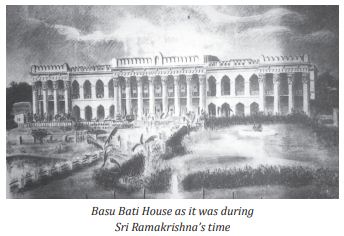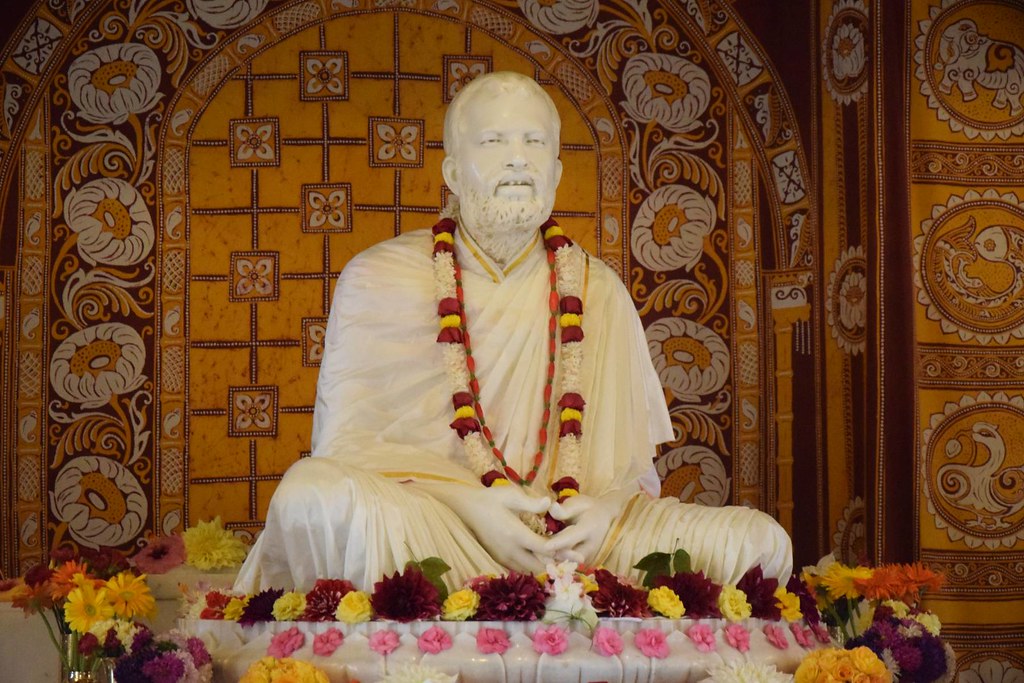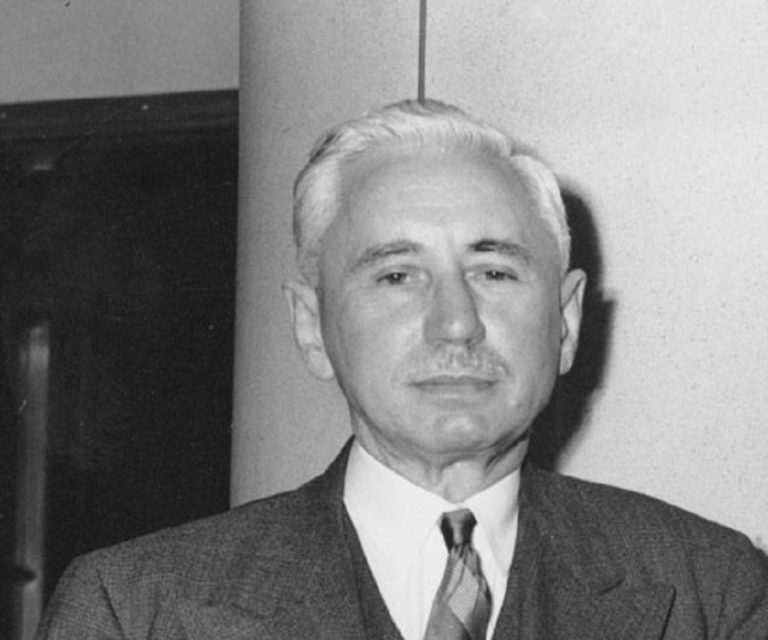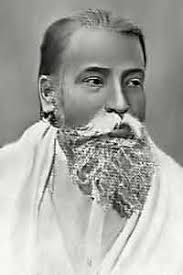This is a re-presentation of one of Sri Ramakrishna’s visits to Kolkata, which is found in The Gospel of Sri Ramakrishna in the chapter ‘Visit to Nanda Bose’s House’. In this time of social distancing when social visits are unwelcome, let us swing back in time and accompany Sri Ramakrishna and his disciples on this visit.
It was 28 July 1885. The time was about 3 o’clock in the afternoon. It is very hot and humid. Sri Ramakrishna was sitting in Balaram’s drawing room with some devotees.1 Narayan, a close devotee, mentioned to the Master that Nanda Bose, an aristocrat of Baghbazar, had many pictures of gods and goddesses in his house. So, Sri Ramakrishna decided to visit Nanda Bose’s house (hereafter called Basu Bati). Putting on a pair of black varnished slippers and a red-bordered cloth and repeating the name of God, he got into a palanquin which had been brought for him. M., or Mahendranath Gupta, the author of The Gospel of Sri Ramakrishna, walked alongside the palanquin.2
The owners
According to the family records, Nanda Lal Basu and Pasupati Basu (later called Nanda Lal Bose and Pasupati Bose), sons of the renowned Basu family of Kantapukur in Shyambazar, North Kolkata, were the owners of Basu Bati. In about 1876, they acquired a large plot of land in Baghbazar and constructed the large mansion known as Basu Bati.3
In the nineteenth century, Kolkata was divided into two towns. There was the ‘White Town,’ where British officers and other Europeans lived, and the ‘Black Town’, where the natives lived. To avoid being counted as residents of the ‘inferior’ Black Town, many zamindar families in the Black Town had designed or remodeled their homes according to the European style of architecture prevalent at that time.4 Many of these buildings combined a Western exterior and an Eastern interior, with a large, open-spaced inner court-yard that had a Thakur dalan. Thakur dalan is a verandah or raised platform with a roof along the outside wall of a house. Large religious festivals or pujas were usually held there.5
Inside the Basu Bati, there were paintings depicting Hindu puranic figures and also European aristocrats. The portraits of the Hindu gods and goddesses were painted by the famous 19th century Bengali artist Bamapada Banerjee (1851-1932).6 Sri Ramakrishna was especially eager to see these paintings.
The architect
The architect of Basu Bati was Nilmani Mitra, who also happened to be the first Bengali to qualify as a civil engineer. Mitra’s family is connected to Calcutta’s history in a number of ways. He was a descendant of Rudreshwar Mitra, who was the elder brother of Kashishwar Mitra, who had built the famous Kashi Mitra Ghat on the Ganga River. In addition to a number of palatial buildings in Calcutta, Mitra had also designed the chariot at the Jagannath temple of Mahesh in Serampore, which both Sri Ramakrishna and Holy Mother Sri Sarada Devi had visited.7
Other historic events in Basu Bati
In addition to Sri Ramakrishna’s visit, Basu Bati witnessed some more historical events. In 1891 when a dispute arose between the Star Theater and Girish Ghosh, the father of Bengali Theater, the Basu brothers allowed Girish Ghosh’s plays to be held at Basu Bati. In 1897 on his victorious return to Kolkata from the West, Swami Vivekananda was first taken in a horse carriage from Sealdah train station to Ripon Women’s college, and then to Basu Bati. On the way, the young students unharnessed the horses and pulled Swamiji’s carriage themselves upto Basu Bati.8 Later, in 1905 when the British partitioned Bengal, Basu Bati saw the Hindus and Muslims opposing the partition coming together in a friendship thread-tying ceremony. Finally, when the British imposed tax on Indian cotton, advocates of the Swadeshi movement started spinning their own clothes in Basu Bati and encouraged the locals to purchase Indian-made homespun clothing.9
With Sri Ramakrishna
Most likely, Sri Ramakrishna would have headed north, past Girish Ghosh’s house on what is today known as Central Avenue, and then turned right onto Baghbazar Avenue. After walking for a kilometre on Baghbazar Avenue, when they turned left they would have beheld Basu Bati, a majestic, huge structure whose sixteen monumental decorative columns each topped by iron brackets, (and approximately 42 – 45 feet from base to top and 7.5 feet in diameter) greeted the visitors. The front façade was over 270 feet.10 Basu Bati was inside a sprawling estate covering 14 acres and extended up to what is now Acharya Prafulla and Jagadish Chandra Bose Roads. It contained a large garden, a stable, and even a zoo!11

As the palanquin “entered the gate of Nanda’s house, crossed the spacious square, and stopped in front of the building, the members of the family greeted” Sri Ramakrishna. Sri Ramakrishna went up the wooden staircase and proceeded to a large room on the first floor whose roof was around 25 feet high, and on whose walls hung the pictures of gods and goddesses.12 Nanda Bose and his brother Pasupati saluted Sri Ramakrishna.
Surrounded by devotees, Sri Ramakrishna went around seeing the pictures. “The first photo was of Vishnu with four arms. At the very sight of it, Sri Ramakrishna was overwhelmed with ecstasy and simply sat down on the floor and remained a few minutes in that spiritual mood.”13 In the second picture Rama was blessing Hanuman, with His hand on the devotee’s head. Hanuman’s gaze was fixed on Rama’s Lotus Feet. Sri Ramakrishna gazed at the picture for a long time and exclaimed with great fervour, “Ah me! Ah me!” Then when he saw the picture of the Vaman avatar, he joyfully cried out, ‘Vaman!’ and looked at him intently. At the sight of Annapurna’s picture, he exclaimed with great fervour, “Grand! Grand!”
After seeing some more pictures of Sri Krishna, Radha, Kali and others, Sri Ramakrishna went and sat with Nanda Bose and others. He told them “I am very happy today. It is grand. You are a real Hindu. You have these pictures instead of English ones.” In that room there hung on the wall, Keshab Sen’s Navavidhan picture in which Sri Ramakrishna also figured. When Sri Ramakrishna saw that picture, a person pointed out, “You are in that picture as well.” Sri Ramakrishna replied, “Yes, everything is there. This is the ideal of modern times.”14
Explaining the meaning of this picture, Srimat Swami Prabhananda Ji, one of the present vice-presidents of the Ramakrishna Order, writes: “In the picture, Sri Ramakrishna draws Keshab Chandra’s attention to a wonderful scene in front of them… which features a church, mosque, and temple…also Christ and Chaitanya can be seen dancing in divine ecstasy [amidst] devotees of God belonging to different religions and denominations including a Vaishinava, a Ramanujite, a Tantrika, a Sikh, an Anglican Christian, a Chinese follower of Confucianism, a Muslim, and a Parsee…Pointing to this group Sri Ramakrishna drives home the idea of the harmony of religions.”15
Sri Ramakrishna then entered into an ecstatic spiritual mood and spoke with the Divine Mother. A few minutes later, looking at the house he said, “It is a huge mansion. But what does it consist of? Bricks, timber, and clay.”16 Indeed, today that palatial building is in a dilapidated condition and nothing is left but just ‘bricks, timber, and clay.’ The present address is 65/1A Baghbazar St., Baghbazar.
There soon followed a very interesting conversation between the rational bohemian Basu brothers and Sri Ramakrishna. We will understand the structure and implications of that conversation in the next issue.
(To be continued …)
References
1) The Gospel of Sri Ramakrishna. p. 815
2) https://www.livehistoryindia.com/ amazing-india/2019/07/21/basu-bati-a-timelesslegacy-of-bengali-heritage, Sanjana Ray
3) Ibid. But as the author points out, Basu Bati did not merely mimic European styles; it was a “blend of Bengali and Islamic influences”.
4) http://double-dolphin.blogspot.com/2017/07/ basu-bati-bagbazar-calcutta-kolkata.html, Deepanjan Ghosh.
5) Ibid, Ghosh.
6) For further details of Thakur’s visit to Mahesh, please see Journeys with Ramakrishna by Swami Prabhananda, pp.254-64.
7) Life of Swami Vivekananda by His Eastern and Western Disciples. 2: 217-218.
8) http://double-dolphin.blogspot.com/2017/07/basubati-bagbazar-calcutta-kolkata.html, Deepanjan Ghosh.
9) Approximate measurements were done by Architect Abhishek Bhattacharya of Entally, Kolkata on 6 April 2020.
10) The Great Houses of Kolkata (1750-2006), Joanne Lea Taylor, p. 129
11) Srisrikathamrita, Srima, p.875. Though not mentioned in the English Gospel of Ramakrishna, it is mentioned in the Bengali Kathamrita that Sri Thakur went upstairs and entered the large hall, ‘uparer halgharer upasthita hoylen’.
12) Gospel. p. 816
13) Ibid.,
14) Ibid.,
15) More about Ramakrishna. Swami Prabhananda, p. 203
16) Gospel. P. 817
Source : Vedanta Kesari, June, 2020


